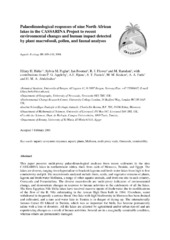Palaeolimnological responses of nine North African lakes in the CASSARINA Project to recent environmental changes and human impact detected by plant macrofossil, pollen, and faunal analyses
| dc.contributor.author | Birks, Hilary H. | eng |
| dc.contributor.author | Peglar, Sylvia M. | eng |
| dc.contributor.author | Boomer, Ian | eng |
| dc.contributor.author | Flower, Roger J. | eng |
| dc.contributor.author | Ramdani, Mohammed | eng |
| dc.contributor.author | Appleby, P. G. | eng |
| dc.contributor.author | Bjune, Anne Elisabeth | eng |
| dc.contributor.author | Patrick, Simon T. | eng |
| dc.contributor.author | Kraïem, Mohammed M. | eng |
| dc.contributor.author | Fathi, Adel A. | eng |
| dc.contributor.author | Abdelzaher, H. M. A. | eng |
| dc.date.accessioned | 2007-12-20T09:03:57Z | |
| dc.date.available | 2007-12-20T09:03:57Z | |
| dc.date.issued | 2001 | eng |
| dc.Published | Aquatic Ecology 2001 35 (3/4): 405-430 | en |
| dc.identifier.issn | 1386-2588 | en_US |
| dc.identifier.uri | https://hdl.handle.net/1956/2512 | |
| dc.description.abstract | This paper presents multi-proxy palaeolimnological analyses from recent sediments in the nine CASSARINA lakes in northernmost Africa, three from each of Morocco, Tunisia, and Egypt. The lakes are diverse, ranging from hypersaline to brackish lagoons and fresh-water lakes from high to low conductivity and pH. The macrofossils analysed include fruits, seeds, and vegetative remains of plants, lagoon and fresh-water Mollusca, a range of other aquatic animals, and from one site in each country, Ostracoda and Foraminifera. The diverse macrofossils are multi-proxy indicators of environmental change, and demonstrate changes in response to human activities in the catchments of all the lakes. The three Egyptian Nile Delta lakes have received massive inputs of fresh-water due to modifications of the flow of the R. Nile culminating in the Aswan High Dam built in 1964. Elsewhere, water withdrawal is frequently a serious threat. One lake with high biodiversity in Morocco has been drained and cultivated, and a rare acid-water lake in Tunisia is in danger of drying up. The internationally famous Garaet El Ichkeul in Tunisia, which was so important for birds, has become permanently saline with a loss of diversity. All the lakes are affected by agricultural and/or urban run-off and are experiencing changes as a result of human activities. Several are in a marginally sustainable condition, whereas others are permanently damaged. | en_US |
| dc.language.iso | eng | eng |
| dc.publisher | Springer | en_US |
| dc.subject | Aquatic ecosystem responses | eng |
| dc.subject | Aquatic plants | eng |
| dc.subject | Mollusca | eng |
| dc.subject | Multi-proxy study | eng |
| dc.subject | Ostracoda | eng |
| dc.subject | Sustainability | eng |
| dc.title | Palaeolimnological responses of nine North African lakes in the CASSARINA Project to recent environmental changes and human impact detected by plant macrofossil, pollen, and faunal analyses | en_US |
| dc.type | Peer reviewed | |
| dc.type | Journal article | |
| dc.identifier.doi | https://doi.org/10.1023/a:1013265310922 | |
| dc.subject.nsi | VDP::Matematikk og Naturvitenskap: 400::Zoologiske og botaniske fag: 480 | nob |
